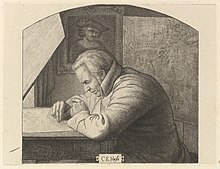Carl Ernst Christoph Hess
Carl Ernst Christoph Hess , also Carl Ernst Heß (born January 22, 1755 in Darmstadt , † July 25, 1828 in Munich ) was an engraver and painter.
origin
His parents were the court instrument maker Johann Heinrich Hess (1712–1768) in Darmstadt and his wife Sabine Christine Roeder
Life
After the early death of his father, he was apprenticed to a sword sweeper in Strasbourg. There he had bad conditions, and his aunt Maria Magdalena Hess soon took him over. In Mannheim she was married to the court medalist, gold chaser and painter Jacob Hohleisen from the Electoral Palatinate . There, Hess started his apprenticeship and learned to be a chaser and medalist . The Elector Maximilian of Bavaria noticed him through a hunting scene he had engraved on a hunting hunter . He went to art school and had access to the collection in Mannheim. His talents were also recognized by the academy director Lambert Krahe , who further promoted him. From 1776 he devoted himself to the art of copper engraving in Augsburg and in 1777 went to Düsseldorf to work on the large gallery work begun by Peter Joseph Krahe . In 1780 he was accepted into the academy and in 1782 appointed court engraver and professor of the academy. In 1783 he went to Munich and from here in 1787 to Italy for a four-year stay, where he studied art in Naples and Rome. There he met numerous greats of his time such as Johann Wolfgang von Goethe , Johann Gottfried Herder , Aloys Hirt and Schlegel.
He had hardly returned to Munich in 1791 when he married Marie Lambertine , the daughter of his academy director. In view of the First Coalition War , the couple left Düsseldorf for a few years before working again on the large gallery work with Francesco Bartolozzi . Hess was a frequent guest on the Pempelfort estate with Friedrich Heinrich Jacobi , where he had the opportunity to acquire a good scientific education. In 1806 the gallery and academy were moved to Munich by Elector Maximilian I. Joseph , who also caught up with the artist Hess.
In the dotted manner, he produced several excellent sheets, for example the barker after Gerard Dou , the Assumption of Mary after Guido Reni , the portrait of Rubens and his wife.
Excellent leaves of larger size are still a holy family according to Raphael and the Last Judgment according to Rubens. In 1806, Hess moved to Munich with the Düsseldorf gallery . Here he completed a St. Hieronymus after Jacopo Palma , the three holy kings after Jan van Eyck and the image of King Maximilian after Stieler .
student
family
In 1791 Hess married Marie Lambertine Katharine Krahe , a daughter of the painter and gallery director Lambert Krahe (1712–1790). The couple had several children including:
- Peter (July 29, 1792 - April 4, 1871), painter ⚭ Franziska Gail (September 4, 1802 - October 1, 1876)
- Heinrich (April 19, 1798 - March 29, 1863) ⚭ Antoinette von Langlois (November 13, 1811 - April 16, 1892)
- Franz (June 27, 1795 - October 7, 1819), painter
- Carl (* 1801; † November 16, 1874), painter ⚭ Margarete von Bäumler (* 1792; † November 20, 1878)
- Katharina (December 27, 1796 - December 9, 1832) 32 1822 Friedrich von Gärtner (1791–1847)
- Lambertine (September 17, 1804 - March 14, 1852) ⚭ 1834 Friedrich von Gärtner (1791–1847)
Other works
- Portrait of King Maximilian I.
Honors
The Heßstrasse in Munich's Maxvorstadt district was named after him and his sons Peter von Hess and Heinrich Maria von Hess .
literature
- Wilhelm Adolf Schmidt: Hess, Carl Ernst . In: Allgemeine Deutsche Biographie (ADB). Volume 12, Duncker & Humblot, Leipzig 1880, p. 295 f.
- Carl Ernst Christoph Hess . In: Hans Vollmer (Hrsg.): General lexicon of fine artists from antiquity to the present . Founded by Ulrich Thieme and Felix Becker . tape 16 : Hansen – Heubach . EA Seemann, Leipzig 1923, p. 576 .
- General German real encyclopedia for the educated classes. 8th edition, 1834, volume 5, p. 254 ( books.google.de ).
Web links
Individual evidence
- ↑ See Georg Kaspar Nagler : Albert Christoph Reindel. In: The monogrammists and those known and unknown artists of all schools who use a figurative sign, the initials of the name, the abbreviation of the same to designate their works, & c. have served. Volume I, 1858, p. 504 and others. ( books.google.de )
| personal data | |
|---|---|
| SURNAME | Hess, Carl Ernst Christoph |
| ALTERNATIVE NAMES | Hess, Karl Ernst |
| BRIEF DESCRIPTION | German engraver |
| DATE OF BIRTH | January 22, 1755 |
| PLACE OF BIRTH | Darmstadt |
| DATE OF DEATH | July 25, 1828 |
| Place of death | Munich |
